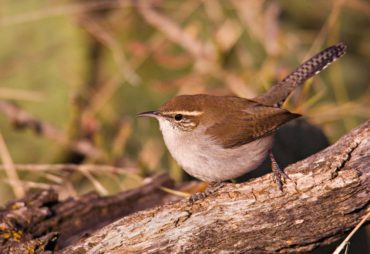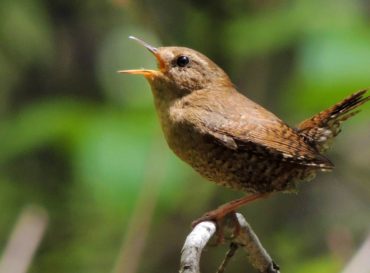
As summer slips into fall, bird activity in West Sound gardens and yards begins to change. Both insect-eating birds and those with a taste for ripening fruit move throughout this region. The wild and domestic fruit crops tempt birds like the robins, cedar waxwings, band-tailed doves and other fruit-eating species to gorge themselves on nature’s bounty.
Insect-eating birds feasting on an insect population at its peak are more difficult to see. They seek out those dark and hidden places where spiders and insects hang out.
One, the Bewick’s wren, is heard more than it is seen. This wren is named after Thomas Bewick (1753-1828).
Bewick (pronounced “Buick,” like the automobile) was an English master woodcarver. His work was used to illustrate books through the use of wood cuts, a process that complemented early printing presses.
He was a close friend of John James Audubon, a naturalist and an artist. Audubon published his original paintings in a massive portfolio, “The Birds of America.” He had painted all the known birds that then existed in the World, and he named one of these new discoveries after his friend. Bewick’s artistic talents were used in publications covering numerous subjects, but the better-known work was the engravings done for two natural-history books, “The General History of Quadrupeds” and “History of British Birds.”
Bewick’s wren is the largest member among the wrens seen west of the Cascade Mountains. Three other wren species can be seen on this side of the state but like all the members in this family, they appear shy. Actually, they are bold little birds given to scolding man or beast when their territory is trespassed on.
The habitat they frequent makes seeing them a challenge. A harsh chatter may issue forth from a fern thicket but the owner of the voice is digging about in the forest floor, ready to eat whatever insect, spider or bug it might find.
A Bewick’s wren scolding in the bushes can sound like a large, buzzing insect. This sound is familiar in late summer and fall when the bug hunting is good. An equally large voice comes from another wren feeding in the dense undergrowth along a forest path.

Pacific wrens differ from their cousin in more than one way. They are much smaller than the Bewick’s wren. This is most notable when their tails are compared. The Bewick’s has a tail that is almost as long as its body. It seems to delight in flicking it back and forth the way dogs wag their tails.
The small Pacific wren has an equally distinctive tail. It is very short and always cocked straight up. Added to its cocky demeanor is its habit of bobbing up and down like a spring-action toy. Repeated and jerky knee-bends accompany a rapid-fire scold that is usually directed at suspected trespassers in its territory.
The sound of its scolding is so fast and nonstop that some have nicknamed this wren the “sewing-machine bird.” It’s easily recognized by anyone who has followed a path through evergreen forests of Douglas fir, Western red cedar and Sitka spruce. Even though this bird is to be expected in both the coastal forest and in the mountains, it also frequents neighborhoods where native trees are part of the landscape.
For decades, Pacific wrens were known as “winter wrens.” Unless a field guide for birds is a recent publication, it will still be found under the former name.
Marsh wrens, another member of the Troglodytidae family, are equally noisy and nonstop when protecting their territory. When it comes to being secretive, this wren tops the others. Like their name implies, their preferred habitat is found among the reeds and cattails of both fresh and saltwater marshes.
When someone approaches their marsh, these birds are immediately aware of this presence. The warning is quickly passed from one location to another. It can be frustrating to stand on the edge of a marsh, trying for a glimpse of this noisy little bird, and see nothing.
They will sit hidden in the cattails and reeds, waiting for the intruder to leave. Even when one bird pops up to take a look around, it drops out of sight in seconds. Their taunting chatter never stops.
It is possible to outwit this bird, especially if you have at least one companion with you. Take up a position where you are concealed or nearly so. Standing behind a utility pole will work. Your companion should then walk away as if giving up waiting for the bird to show itself. Once your companion is out of sight, chances are good that the taunting bird will suddenly reveal itself and sit near the top of the reeds to sound its challenge. It will just as suddenly drop out of sight if you step out of hiding.
If you get the opportunity to see a marsh wren or the Pacific wren burst into voice, it is impressive. They toss their head back, open wide their mouth and then let loose with a harsh, rattling, clicking and buzzy scold. The effort involved is impressive and rivals the performance of any operatic soprano.
There is a fourth member of the wren family that can be seen in the West Sound region. However, house wrens are more restricted when it comes to the areas where they can be found. Chances for seeing them are better on the eastern side of the state or in the East Sound region.
Every now and then, however, they show up in Kitsap County and southward toward Gig Harbor, Tacoma and communities closer to the Cascade mountain range. More than its scold, the house wren’s song gets the attention. These gregarious birds display the singing abilities inherent in this family.
Both the Bewick’s wren and the Pacific wren also have beautiful voices on the rare occasions they use them. Wrens, more than warblers, know how to “warble a happy song.” Most of the time, they prefer to impress with their loud chatter, but a member of the opposite sex can make them sing a different tune.




























Comments